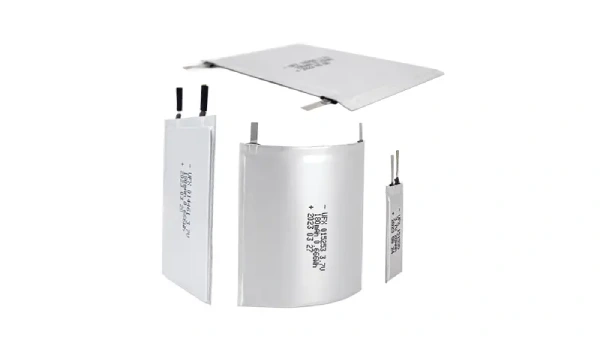As demand for portable devices and electric vehicles grows, reducing weight while maintaining energy capacity becomes imperative. Today’s growing product expectations, from lightweight laptops and smartphones to foldable electronics like drones, require lightweight batteries with high power in a minimal footprint.

Part 1. Why are lightweight batteries important?
Each gram counts lightweight batteries to improve user ergonomics and extend product range/runtime. Lighter options translate directly into increased product appeal and adoption rates. Furthermore, weight impacts transportation costs significantly across industries. Clearly, the importance of lightweight batteries stems from diverse practical and financial factors.
There are several essential reasons why lightweight batteries are beneficial:
- Improves portability and ergonomics of mobile products.
- Extends runtimes and range of electric devices.
- Reduces transportation and material costs.
- Enables new product categories requiring ultra-lightweight power sources.
Part 2. How to make batteries lighter
A lightweight battery involves innovative design, advanced materials, and efficient manufacturing processes.
Researchers and engineers are working on various methods to make batteries lighter, such as:
- Substituting heavyweight materials for lighter alternatives
- Optimizing electrode formulations and compression techniques
- Utilizing porous, nanostructured materials
- Refining manufacturing and cell design processes
For example, compressing electrode materials through advanced rolling techniques also increases energy density by utilizing excess space previously filled by dead weight. Engineers optimize parameters like electrode porosity versus conductivity to maximize the function-to-weight ratio.
Utilize high-energy-density materials such as lithium-ion or lithium-polymer, which offer superior energy storage capacity in a compact and lightweight form.
Optimizing the battery’s internal structure and electrode design can reduce weight without sacrificing performance.
Furthermore, advancements in nanotechnology and composite materials hold promise for developing even lighter and more durable battery solutions.
Available Lightweight Battery Technologies
Some of the lightest battery chemistries currently available include:
- Lithium polymer batteries
- Lithium-ion batteries with silicon or carbon nanotube anode
- Lithium-sulfur batteries (though requiring further cycle life improvements)
- Ceramic separator technologies
Part 3. Benefits and limitations of lightweight batteries
Benefits of Lightweight Batteries
- Lightweight designs boost portability for mobile applications.
- Fewer heavy battery packs reduce overall product encumbrance. This increases user convenience and comfort, which is important in medical devices, wearables, or drones requiring hours aloft.
- Extended operation times emerge from lower payload burdens.
Limitations of Lightweight Batteries
While lighter batteries may be more susceptible to damage from physical impact or extreme conditions, careful handling and protective measures are necessary. Moreover, using exotic materials or advanced manufacturing techniques to achieve lightweight designs can drive up production costs, posing economic challenges for mass adoption.
They may trade off other performance aspects, such as:
- Lower storage capacity
- Reduced discharge rates
- Higher production costs
- The right balance depends on the target application.
Part 4. The lightest batteries
Some leading lightweight battery candidates include lithium polymer and lithium-ion variants utilizing materials like silicon or carbon nanotubes.
Samsung’s SDI division developed a battery tipping scale at just 1.76g per mAh or nearly 50% reduction, versus standard lithium-ion alternatives.
Swiss firm InoBat Auto focuses on EV batteries that integrate ultra-lightweight ceramic separators for weight savings benefits.
Meanwhile, lithium-sulfur cells showcase enormous theoretical capacity/weight ratios but require refining cycle life before widespread use. As research accelerates, even lighter battery chemistries seem possible.
Part 5. Is Lighter always better for batteries?
While pursuing lightweight battery solutions is undoubtedly desirable for many applications, it’s essential to recognize that lighter doesn’t always equate to better. Factors such as energy density, power output, cycle life, and safety must be carefully balanced to meet the specific requirements of each application.
Moreover, the environmental impact of lightweight battery production and disposal should be considered to ensure sustainable and responsible use of resources.
Ultimately, the optimal battery design strikes a delicate balance between weight, performance, and reliability.
While lightweight batteries improve the portability of portable devices, certain applications exist where marginal weight gains emerge as less crucial than other performance metrics.
Factors like battery capacity, lifetime reliability, and intrinsic safety remain top priorities for applications from cordless power tools to energy storage infrastructure.
A delicate balance between lightness, durability, and price/functionality rightly guides engineering priorities depending on end-use cases. Overall system weight, including enclosures, is also a factor alongside naked cell performance. Optimization of lightweight battery for compromise amid multiple design constraints rather than a singular focus on any single metric.
In conclusion, advancing lightweight battery technologies stand poised to revolutionize portable electronics, EVs, and other transportation sectors demanding optimum energy densities. Continuous refinements at the material and structural levels promise even lighter energy storage, enabling bolder product visions. Whether for economic transportability or improved user ergonomics, the importance of lightweight batteries becomes ever increasingly clear. But “lighter” always means more efficient, reliable, or cost-effective, depending on target applications. Balancing priorities remains key.
Part 6. FAQs
-
Are lightweight batteries less durable than conventional batteries?
While lightweight batteries may be more vulnerable to physical damage, advancements in materials and design have significantly improved their durability and reliability. -
Can lightweight batteries deliver the same level of performance as heavier ones?
Yes, lightweight batteries can achieve comparable performance to heavier counterparts, thanks to advancements in energy storage technology and manufacturing processes. -
Are lightweight batteries suitable for high-demand applications such as electric vehicles?
Yes, lightweight batteries play a crucial role in enhancing the efficiency and range of electric vehicles, making them well-suited for high-demand applications. -
What are lightweight batteries?
Lightweight batteries are energy storage devices designed to provide power in a compact and lightweight form, which is ideal for portable electronics, electric vehicles, and aerospace applications. -
How do lightweight batteries differ from traditional ones?
Lightweight batteries typically utilize advanced materials and innovative design techniques to achieve higher energy density and reduced weight compared to traditional batteries. -
Are lightweight batteries less durable?
While lightweight batteries may be more susceptible to physical damage, advancements in materials and design have significantly improved their durability and reliability. -
What are the challenges associated with lightweight batteries?
Challenges include maintaining durability, balancing weight and performance, addressing safety concerns, and managing production costs. -
How are lightweight batteries made?
Lightweight batteries are made using advanced materials such as lithium-ion or lithium-polymer, optimized internal structures, and innovative manufacturing processes. -
Can lightweight batteries be recycled?
Lightweight batteries can be recycled to recover valuable materials and minimize environmental impact. Proper recycling methods ensure responsible disposal and resource recovery.
Related Tags:
More Articles

Overview of Deep Cycle Lithium Battery
In this article, we explore the life, voltage, capacity, and charging considerations of deep cycle lithium batteries.
How Long do Lithium Batteries Last?
How long do lithium batteries last? we will explore the factors that influence the lifespan of lithium batteries and provide insights into their longevity.
How to Choose the Best LiFePO4 Battery?
Choose LiFePO4 batteries for superior performance, safety, and versatility in EVs, UPS, and backup power. This guide helps you make informed decisions.
Get 12v Lithium Car Battery As a Power Source for the Ride
Make the right choice for your vehicle's battery needs by installing a 12 volt lithium car battery. You will enjoy maintenance-free longevity with this change.
Everything About A Small Lithium Ion Battery
Discover the features, uses & future potential of a small lithium ion battery. A compact and tiny powerhouse ideal for smartphones, wearables, drones & more.





